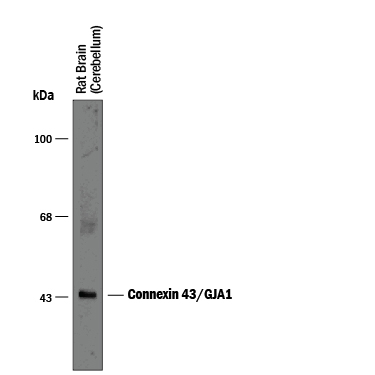Connexin 43/GJA1 Antibody Summary
Applications
Please Note: Optimal dilutions should be determined by each laboratory for each application. General Protocols are available in the Technical Information section on our website.
Scientific Data
 View Larger
View Larger
Detection of Connexin 43/GJA1 by Western Blot. Western blot of rat cerebellar lysate showing specific immunolabeling of the approximately 43 kDa Connexin 43/GJA1 protein.
Reconstitution Calculator
Preparation and Storage
Background: Connexin 43/GJA1
Connexin 43 (Cx43; also gap junction a-1 protein/GJA1) is a 41-44 kDa member of the connexin family, a-type subfamily, of transmembrane proteins. It is the most common type of connexin in cardiac muscle cells, and also occurs in hepatocytes, astrocytes and ovary granulosa cells. It is a 4-transmembrane protein 382 amino acids (aa) in length that contains two cytoplasmic tails. One is 12 aa in length at the N-terminus and the second is 151 aa in length at the C‑terminus. Human and rat Cx43 are 98% aa identical over the entire length of the molecule. Connexins form gap junctions (GJs) which are intercellular channels between cells. Each adjacent cell contributes to a functional channel. The fundamental unit is a “connexon”, or hemi-channel, which is composed of six connexins in a sliding subunit hexamer configuration. The hexamer may be either homomeric or heteromeric. The connexon arrangement provides for the opening and closing of an intersubunit space (or pore) that allows diffusion of molecules 1 kDa or less. It is suggested that the extended C-terminus of each connexin may interact with multiple docking proteins and serve as a plug during closure. Connexons on adjacent cells interact via their extracellular loops to form a GJ channel. When open, these channels allow for the transit of small hydrophilic molecules such as ATP, glucose, IP3 and Ca++. Connexons (or hemi-channels) that do not interact with adjacent cells are also suggested to allow for small molecule transit under unusual circumstances. Cx43 activity is regulated by phosphorylation. The exact effects, however, may be context-specific. In one case, PKC phosphorylation of S368 has been found to decrease GJ channel permeability to select small molecular weight solutes. Alternatively, PKA has been suggested to be the mediator of Cx43 phosphorylation of S365, S368, S369 and S373. In this case, phosphorylation promotes channel activity.
- Sohl, G. and K. Willecke (2004) Cardiovasc. Res. 62:228.
- Willecke, K. et al. (2002) Biol. Chem. 383:725.
- Giepmans, B.N.G. (2004) Cardiovasc. Res. 62:233.
- Vinken, M. et al. (2006) Cell. Signal. 18:592.
- Stout, C. et al. (2004) Curr. Opin. Cell Biol. 16:507.
- Bao, X. et al. (2004) Am. J. Physiol. Cell. Physiol. 286:C647.
- Yogo, K. et al. (2006) J. Reprod. Dev. 52:321.
Product Datasheets
FAQs
No product specific FAQs exist for this product, however you may
View all Antibody FAQsReviews for Connexin 43/GJA1 Antibody
There are currently no reviews for this product. Be the first to review Connexin 43/GJA1 Antibody and earn rewards!
Have you used Connexin 43/GJA1 Antibody?
Submit a review and receive an Amazon gift card.
$25/€18/£15/$25CAN/¥75 Yuan/¥2500 Yen for a review with an image
$10/€7/£6/$10 CAD/¥70 Yuan/¥1110 Yen for a review without an image





